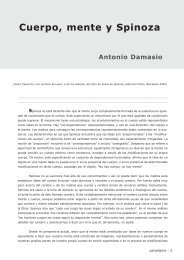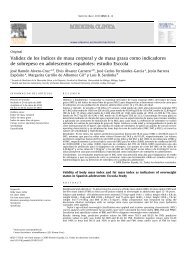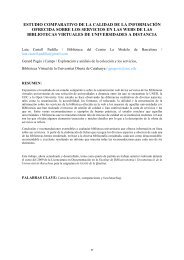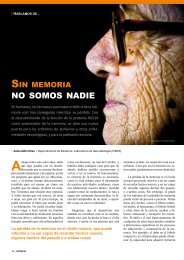Estereotipos negativos hacia la vejez y su relación con variables ...
Estereotipos negativos hacia la vejez y su relación con variables ...
Estereotipos negativos hacia la vejez y su relación con variables ...
You also want an ePaper? Increase the reach of your titles
YUMPU automatically turns print PDFs into web optimized ePapers that Google loves.
Referencias<br />
Sato, S., Shimonaka, Y., Nakazato, K. y Kawaai, C. (1997). A life-span developmental study of age<br />
identity: Cohort and gender differences. Japanese Journal of Developmental Psychology, 8(2),<br />
88-97.<br />
Schaie, K. (1988). Ageism in psychological research. American Psychologist, 43, 170-183.<br />
Schaie, K. (1994). The course of adult intellectual development. American Psychologist, 49, 304-313.<br />
Schaie, K. (1996). Intellectual development in adulthood. En J. E. Birren y K. W. Schaie (Eds.),<br />
Handbook of psychology of aging. 4ª ed. (pp. 266-286). San Diego: Academic Press.<br />
Schaller, M. (1994). The role of statistical Reasoning in the Formation, Preservation and Prevention of<br />
Group Stereotypes. British Journal of Social Psychology, 33. 47-61.<br />
Scheier, M. y Carver, C. (1985). Optimism, Coping and Health: Assessment and Implications of<br />
Generalized Outcome Expectancies. Health Psychology, 4, 219-247.<br />
Scheier, M. y Carver, C. (1987). A model of behavioral self-regu<strong>la</strong>tion: trans<strong>la</strong>ting intention into<br />
action . En L. Berkowitz (Ed.), Advances in experimental social Psychology (Vol. 21, pp. 303-<br />
346). San Diego: Academic Press.<br />
Scheier, M. y Carver, C. (1992). Effects of optimism on psychological and physical well-being:<br />
Theoretical overview and empirical update. Cognitive Therapy and Research, 16(2), 201-228.<br />
Scheier, M. y Carver, C. (1993). On the Power of Positive Thinking: The Benefits of Being<br />
Optimistic. Current Directions in Psychological Science, 2(1), 26-30.<br />
Scheier, M., Carver, C. y Bridges, M. (1994). Distinguishing Optimism from Neuroticism (and trait<br />
anxiety, self-mastery, and self-esteem). A Reevaluation of the Life Orientation Test. Journal<br />
of Personality and Social Psychology, 67(6), 1063-1078.<br />
Schieman, S. (1999). Age and anger. Journal of health and Social Behavior, 40, 273-289.<br />
Schieman, S. y Campbell, J. (2001). Age variations in personal agency and self-esteem: The <strong>con</strong>text of<br />
physical disability. Journal of Aging and Health, 13(2), 155-185.<br />
Schmidt, D. T. y Bo<strong>la</strong>nd. S. M. (1986). Structure of Perceptions of Older Adults: Evidence for<br />
Multiples Stereotypes. Psychology and Aging, 1, 255-260.<br />
Schmitz, M. Sperling, U., Minneman, E. y Jüchtern, J. (1996). Lebenszulfriedenheit, Gestundheit und<br />
Zukunftsperspectiktive. Zeitschrift für Gerontologie, 23, 186-1196.<br />
Schmitz-Scherzer, R. (1991).Sterberlegleitung. En W. D. Oswald, W. M. Herman et al. (Eds.),<br />
Gerontologie (pp. 560-572). Stuttgart: Kolhammer.<br />
Schmitz-Scherzer, R. (1975). Freizeit und Alter. Stuttgart: Kolhammer.<br />
Schneider, H. D. (1970). Sociale Rollen im Erwachenenalter. Frankfurt: Theses Ver<strong>la</strong>g.<br />
Schneider, H. D. y Shiffrin, R. M. (1977). Controlled and automatic human information processing: I.<br />
Detection, search, and attention. Psychological Review, 184, 1-66.<br />
Schonfield, D. (1982). Who Stereotyping Whom and Why? The Gerontologist, 22, 267-272.<br />
Schultz, R. y Hekhausen, J. (1996). A Life Span model of Successful Aging. American Psychologist,<br />
702-714.<br />
251

















